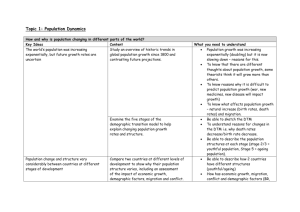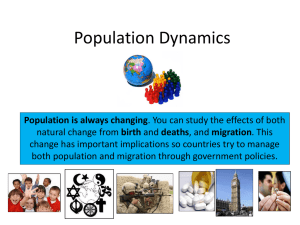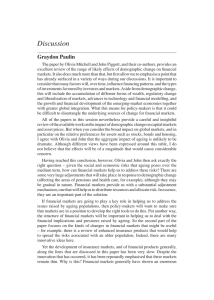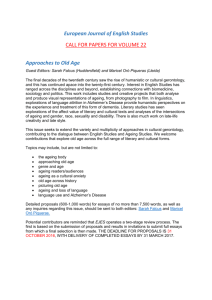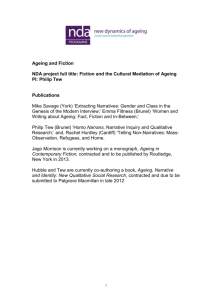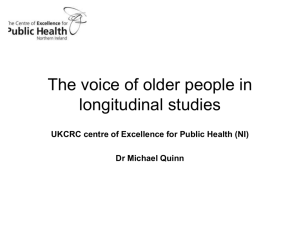Revision - Population - Allerton Grange High School
advertisement
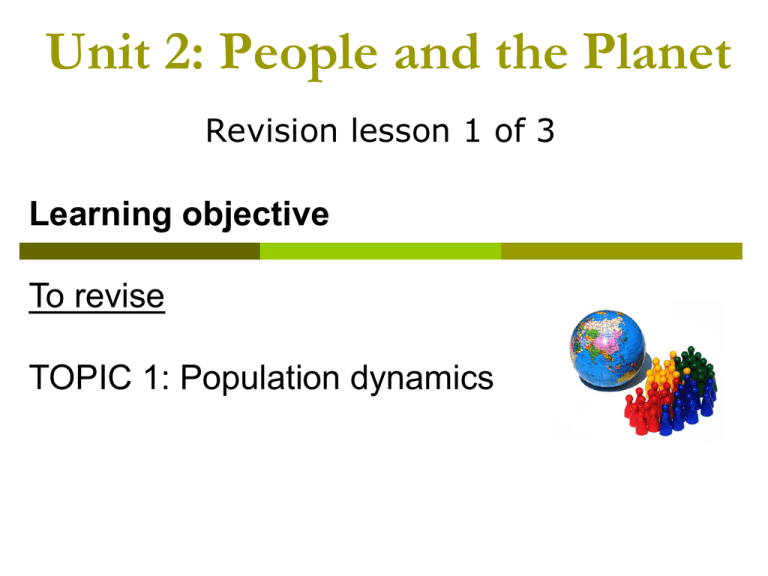
Unit 2: People and the Planet Revision lesson 1 of 3 Learning objective To revise TOPIC 1: Population dynamics KEY CONCEPTS BIRTHS IMMIGRANTS POPULATION DEATHS EMIGRANTS Birth and Death rates change as a country becomes wealthier – WHY? Country Stage in DTM Birth rate Death rate Natural change Swaziland 1 27.0 30.4 - 3.4 Cambodia 2 25.5 8.2 + 17.3 Chile 3 15.0 5.9 + 9.1 UK 4 10.7 10.1 + 0.6 Germany 5 8.2 10.7 - 2.5 Youthful population = ? Ageing population = ? The Demographic Transition Model Reduction in death rates – WHY? 1) 2) 3) 4) 5) 6) Development of modern medicines. This has meant that more and more people are kept alive due to modern practices. Introduction of vaccination and immunisation programmes e.g. smallpox vaccination that helps people to live longer. Cleaner drinking water and better sewage disposal, a lot more people have access to clean drinking water than before. Better healthcare systems – more doctors, nurses and hospitals, means that people can be treated and not die. More hygienic housing and lifestyles. Better diets, e.g. promoting eating ‘5 a day’ Population Pyramids Which population pyramid is which? (Germany, Kenya and USA) Youthful population - Mexico This is when a country has a very high percentage of people under the age of 15. Problems: • Pressure on housing – not enough housing, people living in slums. This is very common around the big cities (New Delhi), where millions of people live in shanty towns with no running water, roads, sewage of any kind. • Pressure on schooling – illiterate population. India’s literacy rate is 60% • Pressure on food supplies - famine, food distribution difficulties. • Pressure on health services – a growth in diseases being spread around and not being dealt with adequately to stop the spread. Ageing population - Japan This is when a country has a very high percentage of people over the age of 65. Problems Health care Pensions Solutions Provide more health care e.g. retirement homes, hospital beds, more undertakers, etc. Skilled health care workers needed Increase tax – not popular Raise retirement age – not popular * this is likely to happen in the UK soon* Abolish state pensions – not popular Why and how can governments change their populations? Increase the population Decrease the population WHY? To stop the population getting too old (ageing) So they need more tax payers/raise taxes To fill job shortages Reduce strain on physical resources – water, food Reduce strain on human resources – jobs, services HOW? Encourage migrants to come Financial incentives for women to have more children: o Better and longer maternity pay o Cash - ‘Baby bonus’ o Ongoing child benefit pay EXAMPLE: Estonia Encourage emigration Financial rewards for having less children Financial penalties for having too many children EXAMPLE: China Case Study: Pro-Natalist: Estonia Case Study: Anti-Natalist – China’s one child Policy http://www.bbc.co.uk/scotland/learning/chinastories/ video_stories/liu_xiao/ Managing migration In 2004 the eastern European countries of Czech Republic, Estonia, Hungary, Poland, Latvia, Lithuania, Slovakia and Slovenia joined the EU (A8 – Accession countries). There has been a notable increase in migrants from these countries coming to the UK for work since 2004. Migration: Advantages and Disadvantages for source and host countries Example: Poland and the UK Sample questions What changes have helped to lower the global infant mortality rate? (2) How and why does the infant mortality rate differ between developing and developed countries? (2) Explain two problems faced by countries with ageing populations. (4) Explain two problems faced by countries with youthful populations. (4) Explain how governments can encourage an increase in the birth rate (4) Using examples, explain the positives and negatives of migration on source and host countries (6)
